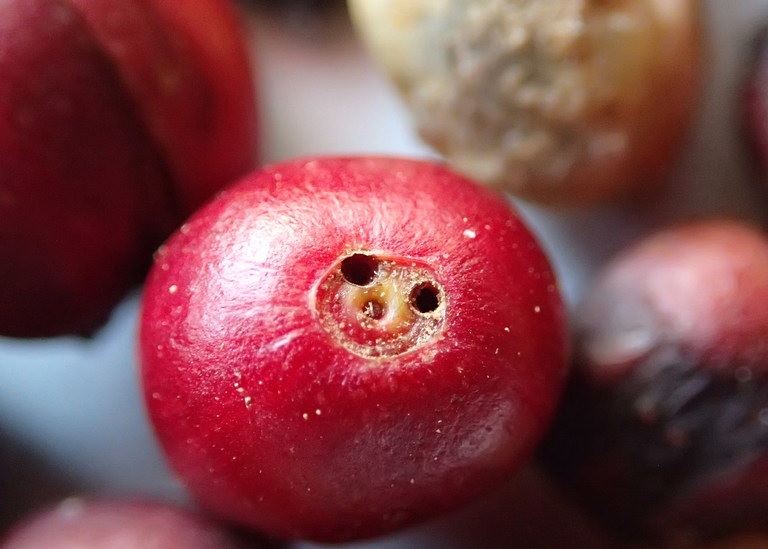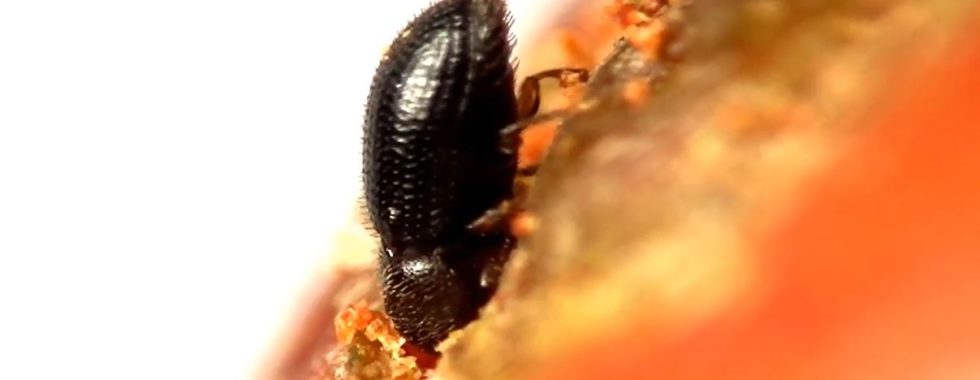The coffee berry borer – a devastating pest
Coffee berry borer (CBB), scientifically referred to as Hypothenemus hampei (Ferrari), is the most devastating pest of coffee across the world. It originated in Africa but has spread to most coffee-growing areas across the world. Severe infestation may lead to crop losses of up to 35% if left unattended, and 100% of the berries may be affected.
It is a specie of beetle that feeds and breeds inside coffee berries. The larvae and the adult borers feed exclusively on the coffee fruit affecting its quality and causing yield loss.
An adult CBB is black and its body ranges from 1.5 to 2.55 mm in length. The female beetle is usually larger than the male and can fly, while males can’t. The beetle is covered with short stiff hairs and has a pair of club shaped antennas.
Environmental conditions
The coffee berry borer likes regions with high humidity and warm temperatures. It prefers temperatures ranging from 18⁰C to 25⁰C and a humidity of 50% to 90%. Such regions include tropical highlands and rainforests.
Lifecycle of coffee berry borer
Coffee berry borer passes through the egg, larvae, pupa, and adult stages of development. The entire development biological cycle occurs inside the fruit. After mating, the female CBB drills a hole and penetrates the coffee berry (usually at the tip of the berry) to start oviposition. It then lays between 30 to 100 fertilized eggs inside the berry during a period of about 20-40 days. Reproduction in CBB tends to favor females and there are about 10 females for every male.
Upon hatching, the larvae start feeding on berries intensifying the damage. Interestingly, copulation occurs among the siblings after which fertilized females fly to look for new berries to colonize. However, the colonizing female stays in the berry until it dies.
The coffee berry borer prefers fleshy berries and attacks them 3 – 5 months after flowering, until the berries ripen. That said, CBB would rather invade older berries than the young ones to increase its chances of survival. The time required for the CBB female to penetrate the berry ranges between 2 and 8 hours. Usually, only one colonizing female infests a coffee berry.
Life cycle growing degree days
| Development stage | Duration in GDD (˚F) |
| Eggs | 140 |
| Larva | 340 |
| Pupa | 75 |
Damage
Although H.hampei is a destructive coffee pest, it only destroys the berries but not any other part of the coffee plant. Infested berries usually fall off the tree or may appear deformed and underweight, affecting the overall quality of the beans. This damage makes the beans fetch a lower price in the market because they barely meet the set standards. Initially, a small hole at the berry tip can be observed. Eventually infected berries rot and fall off prematurely.

A perforated coffee berry. Source: Whitney Cranshaw, Colorado State University, Bugwood.org
Prevention and Control
Control is usually by picking all the remnant berries including those that drop to the ground, in order to cut the cycle development of the CBB. Once picked, the berries can be processed, buried, or burnt. You can also place baited traps across the coffee plantation and prune the coffee and the nearby shady plants to reduce humidity.
Biological treatments include the fungus Beauveria bassiana, which can be used in integrated pest management program. The fungus is sprayed over the coffee berries and infests the CBB females when they start penetrating the fruit. The CBB dies a few days after the infestation. The fungus feeds on nutrients from the CBB body and releases toxins that kill the beetle. After the CBB dies, the fungus covers the carcass with a white mold. The recommendation is to apply the fungus 60 and 150 days after flowering. Average mortality as a result of the application of B. Bassiana is 50%. However, the efficiency of the application depends on several factors, including the formulation used and weather conditions. The favorable environmental conditions for the fungus are moderate temperatures, high humidity, and low insolation.
Insecticides that are effective against the coffee berry borer include acetamiprid, Bifenthrin, Lufenuron, Cypermethrin and others. However, once the CBB has penetrated the fruit, insecticides are not effective any longer. Chemical control, must be therefore applied while the fruit is susceptible to attack by the coffee berry borer.
Additional hosts
The primary host of CBB is the coffee fruit, but reports indicate that the pest feeds on other plant species such as the Melicocca bijuga and Cajanus cajan.



